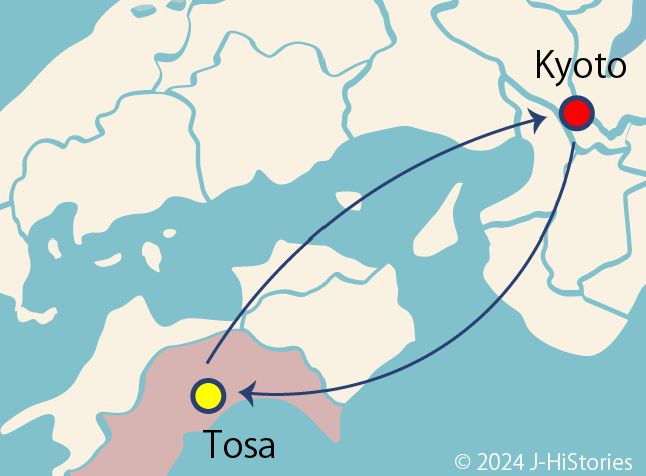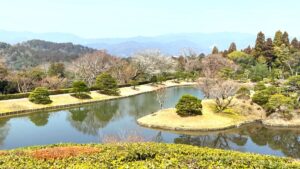Chion-in Temple, Honen's Teaching to Save the People
Chion-in Temple, the head temple of the Jodo sect, is located at the foot of Mt. Higashiyama in Kyoto, built by Tokugawa Ieyasu (1543-1616, 徳川家康) by allotting the temple grounds of Shorenin Monzeki. Hidetada, Ieyasu's successor, donated to the construction of the temple gate, known as Sanmon (三門) or the Three Gate, the largest gate in Japan. Although commonly referred to as Sanmon (山門) or the Mountain Gate, Chion-in's gate expresses the three states of liberation that lead to enlightenment. Chion-in Temple has been saving many people for 850 years since Honen (1133-1212, 法然) first propagated the teaching of Senju Nembutsu: single-minded recitation of chanting saves the people.

Hardships on the People Caused by Battles and Famine
Honen lived about 100 years after the "Age of the Final Dharma" which was believed to have begun in 1052. During this age, a widely read how-to book about achieving an ideal mortal moment to be reborn in the Pure Land, Ojoyoshu, reflected two concepts: Onriedo (abhorrence of living in this impure land) and Gongujodo (seeking rebirth in the Pure Land). In those days, the Hogen and the Heiji Disturbances broke out in 1156 and 1160, respectively, as the first instances in Japanese history where two major samurai clans, the Minamoto and Taira, were involved in the political power struggle between the Emperor and nobles. The Minamoto clan was defeated by the Taira Kiyomori (1118-1181, 平清盛), and Minamoto Yoritomo (1147-1199, 源頼朝) was exiled to the Izu province from Kyoto in 1160. 20 years later, in 1180, the Genpei War broke out, led by Minamoto Yoritomo, and overthrew the Taira clan. The war spread across the country from Kamakura to Kyoto, Dannoura in the west, and Hiraizumi in the north, causing turmoil and confusion, and heavily affecting the nameless people. In addition, a famine broke out in 1181, resulting in massive deaths from starvation and an exodus of farmers who abandoned their lands and rushed to Kyoto, leading to the collapse of social order.
Honen Revolutionized Buddhist Society by Making It Possible to Enter the Pure Land Without Severe Ascetic Practices

Buddhism originally started to pray for peace and security of the nation and Imperial Family in the Asuka period (592-710), led by Prince Shotoku, and in the Nara period (710-794). In the Heian period (794-1185), two monks, Saicho and Kukai, climbed mountains (Ex, Enryakuji Temple on Mt.Hiei and Kongobuji Temple on Mt. Koya), read difficult scriptures, undertook arduous practices, and devoted their lives to training to attain enlightenment. However, such practices were insufficient to save people in times of turmoil. Honen continued his practice at Enryakuji but was unable to attain enlightenment. Therefore, he searched for "a way that even a fool like me could be saved", or “Buddhism for salvation". After reading numerous sutras, he finally found one sentence in the Kangyoso (観経疎): If you single-mindedly chant the name of Amitabha Buddha, you will surely be reborn in the Pure Land. It was when Honen was 43 years old, in 1175, that he found the way to save the people by chanting "Namu Amidabutsu" (Amida Buddha). He then left Enryakuji and founded the Jodo sect to offer salvation to people. His revolutionary doctrine attracted many people because it was very simple. It's just single-mindedly reciting the Amida Buddha, and then everyone could attain Buddhahood by transcending the Six Realms immediately and being reborn in the Pure Land of Ultimate Bliss all at once, without requiring ascetic practices.
Honen's Teaching was Too Radical to Accept

Honen’s doctrine was too radical for conventional Buddhists to accept. In 1207, the Imperial Court finally imposed severe punishments, including capital offenses for four people and exile for eight. Honen was exiled to Tosa (Kochi) at the age of 75. Five years later, he was forgiven and returned to Kyoto, but he passed away the following year at the age of 80. Honen's follower, Shinran (1173-1263, 親鸞), spread Honen's true doctrine about Senju-Nembutsu.
Save Those Who Cannot be Saved by Conventional Teaching

The period in which Honen and Shinran lived was characterized by chaos in the late Heian period (794-1185). Ordinary people, such as farmers. They faced battles, natural disasters, and continuous major earthquakes and typhoons, leaving them with no power to survive. Famine was rampant, and corpses littered the streets, leading to a sense of hopelessness and despair. The teaching that "the moment you believe in Amida Buddha, you are guaranteed to be reborn in the Pure Land” brought hope to the people, saving them from their suffering. Honen's revolutionary approach to Buddhism through the practice of "Nembutsu" passed down their beliefs to future generations. We invite you to visit Chioin-in Temple and reflect on the history of Honen. Anyone who stops by will feel the warmth of salvation.
Honen and Shinran Timeline
| 1133 | Honen was born | 1 | Heian |
| 1145 | Honen started to study Buddhism at Hieizan Enryakuji Temple | 13 | |
| 1052 | "Age of the Final Dharma" was believed to begin in 1052 | 20 | |
| 1156 | Hogen war | 24 | |
| 1159 | Heiji war | 27 | |
| 1173 | Shinran was born | 41 | |
| 1175 | Honen attained Senju Nenbutsu | 43 | |
| 1185 | Minamoto Yoritomo established Kamakura Shogunate | 53 | Kamakura |
| 1186 | Honen debated Senju Nenbutsu with Tendai sect's Buddhists | 54 | |
| 1201 | Shinran stadied under Honen | 69 | |
| 1211 | Honen was forgiven for his exile. | 79 | |
| 1212 | Honen passed away | 80 |
Recommendations to visit
Chion-In Temple
- Access: 30 minutes from Kyoto Station. Take bus #206 bound for "Karasumakitaoji (烏丸北大路)” at A2 or D2. Get off at "Chion-in-mae(知恩院前)" bus stop, then a 5-minute walk.


